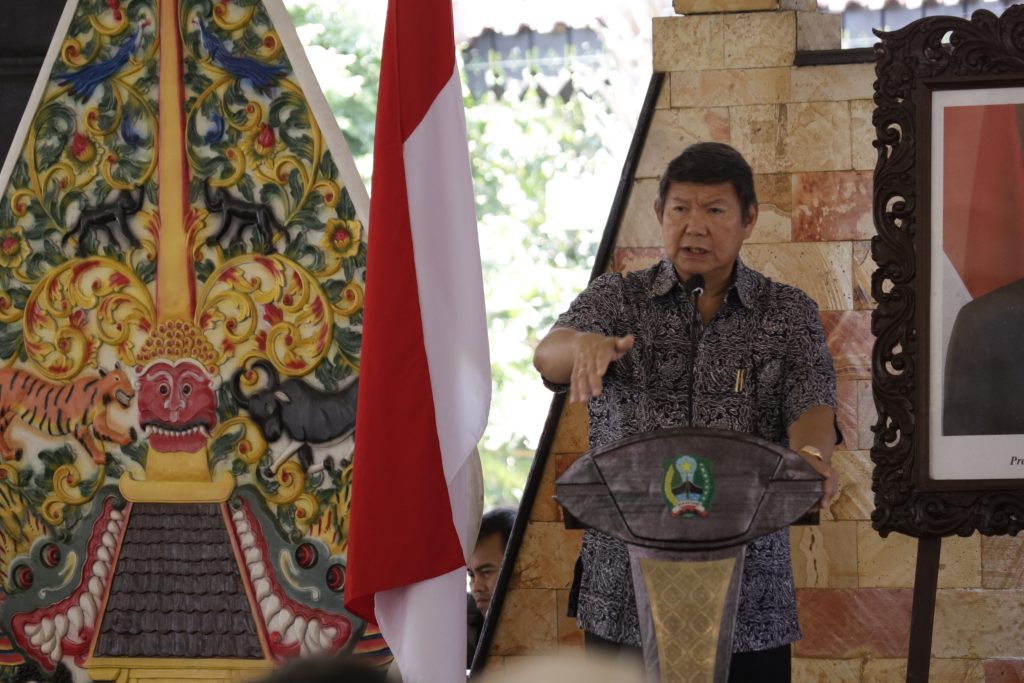Understanding Magetan History and Socio-culture through the Life of Raden Ronggo Prawirodirjo III
Magetan, 25 August 2023—Arsari Djojohadikusumo Foundation (YAD) together with KPG Gramedia Publishing and Magetan Regency launched the Madiun Raya Trilogy: The Last Bull of the Yogyakarta Sultanate. This book is a narrative covering the history of Indonesia, specifically Madiun Raya, which is often associated with the Indonesian Communist Party (PKI) rebellion in 1948. However, long before the PKI rebellion, there were various events that were more prominent and impactful. Madiun Raya became one of the epicenters of resistance to Dutch colonialism and imperialism in the 19th century.



The events of 1948 was so impactful that it became a concern for several influential figures of Madiun Raya. Thus, they proposed an initiative to compile the history of the past Madiun Residency in a trilogy.
This initiative began in 2020 with immense support from various parties. In October 2021, two books were published. The first book was “Between Lawu and Wilis: Archaeology, History and Legends of Greater Madiun Based on the Notes of Lucien Adam (Resident of Madiun 1934–38)”. This book is a translation of five Dutch articles by Lucien Adam. Four articles reveal the early modern history of Madiun Raya (16th to 19th centuries), while one article covers the classical period (Hindu-Buddhist).
In this book, readers can experience the transition to Islam, the growth of fief territories which brought leading centers of Islamic studies, and the influence of the Java War (1825–1830) in this region. This book provides a European perspective that not only analyzes, but also understands the characteristics of Madiun Raya.
Between Lawu and Wilis is complemented by the works of two other authors: the writings of Fokko Fokkens Sr (1852–1922) and Akhlis Syamsal Qomar, a young Madiun historian. Fokkens Sr discusses the Pesantren Perdikan Tegalsari (Ponorogo) which Adam refers to when he told the story of the self-exile of Pakubuwono II (1711–49; reigned 1726–49). Meanwhile, Akhlis wrote about the Banjarsari Perdikan Islamic Boarding School (Madiun), painting a picture to complete our understanding of the perdikan villages in Madiun Raya.
The second book, “The Tale of Brang Wétan: Based on Babad Alit and Babadé Nagara Patjitan”. It covers two local chronicles on the history of various regions, including Madiun Raya. The two chronicles are Babad Alit (1911) and Babadé Nagara Patjitan (1924).
Upon further research, it turned out that these two chronicles are quite obscure. In various writings discussing the history of East Java—especially the Ponorogo and Pacitan regions—the only instance when two chronicles were referred to in depth was by a historian specializing in Madiun history, Ong Hok Ham (1933–2007).
Ong used the two chronicles as literary basis for his dissertation at Yale University in 1975, which Indonesian version was published in 2018. Before more people could access them, the two chronicles had been moved abroad, becoming part of the collection of the Universiteitsbibliotheek in Leiden, the Netherlands.
In the Tale of Brang Wétan, the themes of power contestation, religious dynamics, and important figures in this region are explained through the perspective of local scribes. This was further strengthened by a report on the journey of the Pollux, a Dutch ship, to compare and contrast the details from local sources.
The Final Trilogy
The Last Bull of the Yogyakarta Sultanate: The History of Raden Ronggo Prawirodirjo III from Madiun, around 1779–1810 (KPG, August 2022) is the conclusion of the Madiun Raya Trilogy. This book explores the life of Raden Ronggo Prawirodirjo III (circa 1779–1810), Regent of East Mancanegara under the Sultanate of Yogyakarta (1796–1810).



Raden Ronggo, who lived in the midst of chaos during the Dutch colonial period in Java, became an important figure who played a big role before the collapse of the old order post-Java War (1825–1830). It may not be an understatement to say that he might have indirectly ushered in the birth of a new order in Java.
When Dutch-French administration under Marshal Herman Willem Daendels (served as Governor General 1808–10) came to Java, Raden Ronggo reacted by opposing European domination which had changed from economic to political domination. One of the consequences of this shift is the erosion of Java’s socio-cultural order.
It was this erosion of the socio-cultural order that Raden Ronggo fought against on 20 November–17 December 1810. The short-lived resistance of the Regent of East Mancanegara would later become an example for the famous resistance leader of the 19th century, Prince Diponegoro.
In his autobiography, Prince Diponegoro said that “saicale Raden Rongga/ nenggih nagri Ngyayogya/ wus tan ana banthengipun [after the parting of Raden Ronggo, the Kingdom of Yogyakarta no longer had a guardian]”.
In this book, Akhlis Syamsal Qomar uses European and Javanese sources to describe Raden Ronggo’s resistance. A resistance that had an important influence on the history and culture of the Greater Madiun area.
Explaining the Trilogy
All three books in this trilogy seem to have independent themes. But, they have a common thread that is the determination to explore and divulge the history of Madiun Raya in more depth.
The first book, which focuses on the European perspective, provides an overview of the region’s characteristics. The second book, which highlights the local perspectives, provides in-depth understanding for local residents. Meanwhile, the third book puts the spotlight on prominent figures who fought against European domination. The Madiun Raya Trilogy is not just a collection of information, but also the first step in producing rich and more diverse historical writings. With the methodical approach applied in this trilogy, we hope that it may spark enthusiasm to further explore local history and nurture appreciation in the cultural heritage of Madiun Raya.***

